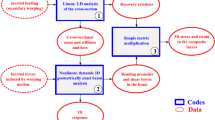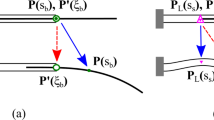Abstract
In flexible multibody systems, it is convenient to approximate many structural components as beams or shells. Classical beam theories, such as Euler–Bernoulli beam theory, often form the basis of the analytical development for beam dynamics. The advantage of this approach is that it leads to a very simple kinematic representation of the problem: the beam’s section is assumed to remain plane and its displacement field is fully defined by three displacement and three rotation components. While such an approach is capable of capturing the kinetic energy of the system accurately, it cannot represent the strain energy adequately. This paper presents a different approach to the problem. Based on a finite element discretization of the cross-section, an exact solution of the theory of three-dimensional elasticity is developed. The proposed approach is based on the Hamiltonian formalism and leads to an expansion of the solution in terms of extremity and central solutions. Kinematically, the problem is decomposed into an arbitrarily large rigid-section motion and a warping field. The sectional strains associated with the rigid-section motion and the warping field are assumed to remain small. As a consequence of this kinematic decomposition, the governing equations of the problem fall into two distinct categories: the equations describing geometrically exact beams and those describing local deformations. The governing equations for geometrically exact beams are nonlinear, one-dimensional equations, whereas a linear, two-dimensional analysis provides the detailed distribution of three-dimensional stress and strain fields. Within the stated assumptions, the solutions presented here are the exact solution of three-dimensional elasticity for beams undergoing arbitrarily large motions.



















Similar content being viewed by others
References
Bauchau, O.A., Craig, J.I.: Structural Analysis with Application to Aerospace Structures. Springer, Dordrecht (2009)
Giavotto, V., Borri, M., Mantegazza, P., Ghiringhelli, G., Carmaschi, V., Maffioli, G.C., Mussi, F.: Anisotropic beam theory and applications. Comput. Struct. 16(1–4), 403–413 (1983)
Mielke, A.: Saint-Venant’s problem and semi-inverse solutions in nonlinear elasticity. Arch. Ration. Mech. Anal. 102, 205–229 (1988)
Mielke, A.: Normal hyperbolicity of center manifolds and Saint-Venant’s principle. Arch. Ration. Mech. Anal. 110, 353–372 (1990)
Mielke, A.: Hamiltonian and Lagrangian Flows on Center Manifolds with Applications to Elliptic Variational Problems. Lecture Notes in Mathematics, vol. 1489. Springer, Berlin (1991)
Zhong, W.X.: A New Systematic Methodology for Theory of Elasticity. Dalian University of Technology Press, Dalian (1995)
Zhong, W.X., Xu, X.S., Zhang, H.W.: Hamiltonian system and the Saint-Venant problem in elasticity. Appl. Math. Mech. 17(9), 827–836 (1996)
Yao, W.A., Zhong, W.X., Lim, C.W.: Symplectic Elasticity. World Scientific, New Jersey (2009)
Morandini, M., Chierichetti, M., Mantegazza, P.: Characteristic behavior of prismatic anisotropic beam via generalized eigenvectors. Int. J. Solids Struct. 47, 1327–1337 (2010)
Berdichevsky, V.L.: On the energy of an elastic rod. Prikl. Mat. Meh. 45(4), 518–529 (1982)
Hodges, D.H.: A review of composite rotor blade modeling. AIAA J. 28(3), 561–565 (1990)
Bauchau, O.A., Han, S.L.: Three-dimensional beam theory for flexible multibody dynamics. J. Comput. Nonlinear Dyn. 9(4), 041011 (2014). 12 pp.
Simo, J.C., Vu-Quoc, L.: On the dynamics in space of rods undergoing large motions—a geometrically exact approach. Comput. Methods Appl. Mech. Eng. 66(1), 125–161 (1988)
Borri, M., Merlini, T.: A large displacement formulation for anisotropic beam analysis. Meccanica 21, 30–37 (1986)
Danielson, D.A., Hodges, D.H.: A beam theory for large global rotation, moderate local rotation, and small strain. J. Appl. Mech. 55(1), 179–184 (1988)
Bauchau, O.A.: Flexible Multibody Dynamics. Springer, Dordrecht (2011)
Volovoi, V.V., Hodges, D.H., Berdichevsky, V.L., Sutyrin, V.G.: Dynamic dispersion curves for non-homogeneous, anisotropic beams with cross sections of arbitrary geometry. J. Sound Vib. 215, 1101–1120 (1998)
Lanczos, C.: The Variational Principles of Mechanics. Dover, New York (1970)
de Saint-Venant, J.C.-B.: Mémoire sur la torsion des prismes. Rec. Savants Étrang. 14, 233–560 (1855)
Simo, J.C.: The three-dimensional dynamic problem. Part I. A finite strain beam formulation. Comput. Methods Appl. Mech. Eng. 49(1), 55–70 (1985)
Simo, J.C., Vu-Quoc, L.: A three-dimensional finite strain rod model. Part II. Computational aspects. Comput. Methods Appl. Mech. Eng. 58(1), 79–116 (1986)
Danielson, D.A., Hodges, D.H.: Nonlinear beam kinematics by decomposition of the rotation tensor. J. Appl. Mech. 54(2), 258–262 (1987)
Atilgan, A.R., Hodges, D.H.: Unified nonlinear analysis for nonhomogeneous anisotropic beams with closed cross sections. AIAA J. 29(11), 1990–1999 (1991)
Atilgan, A.R., Hodges, D.H., Fulton, M.V.: Nonlinear deformation of composite beams: unification of cross-sectional and elastica analyses. Appl. Mech. Rev. 44(11), S9–S15 (1991)
Borri, M., Ghiringhelli, G.L., Merlini, T.: Linear analysis of naturally curved and twisted anisotropic beams. Compos. Eng. 2(5-7), 433–456 (1992)
Timoshenko, S.P., Goodier, J.N.: Theory of Elasticity, 3rd edn. McGraw-Hill, New York (1970)
Author information
Authors and Affiliations
Corresponding author
Appendices
Appendix A: Hamiltonian matrices
Matrix  , of size 2n×2n, is said to be Hamiltonian if it satisfies the following property
, of size 2n×2n, is said to be Hamiltonian if it satisfies the following property

where the skew-symmetric matrix  is defined as
is defined as

Note the following properties of matrix  :
:


In view of these properties, the definition (73) of Hamiltonian matrices can be recast as  . Because matrix
. Because matrix  is skew-symmetric, the following property holds for any vector \(\underline{\mathcal{U}}\):
is skew-symmetric, the following property holds for any vector \(\underline{\mathcal{U}}\):

Property (73) implies that the most general form of a Hamiltonian matrix is

where matrices  ,
,  , and
, and  are of size n×n, and matrices
are of size n×n, and matrices  and
and  are symmetric. Clearly, the transpose of a Hamiltonian matrix is also Hamiltonian.
are symmetric. Clearly, the transpose of a Hamiltonian matrix is also Hamiltonian.
1.1 A.1 Eigenvalues of Hamiltonian matrices
Let λ and μ be two eigenvalues of a Hamiltonian matrix and the associated eigenvectors are denoted \(\underline{\mathcal{U}}_{\,\lambda}\) and \(\underline{\mathcal{U}}_{\,\mu }\), respectively, i.e.,  and
and  . Pre-multiplying the first equation by
. Pre-multiplying the first equation by  and the second by
and the second by  leads to
leads to  and
and  , respectively. Because matrix
, respectively. Because matrix  is symmetric, the right-hand sides of these two equations are identical, and subtraction yields
is symmetric, the right-hand sides of these two equations are identical, and subtraction yields  . If λ+μ≠0, the following symplectic orthogonality results:
. If λ+μ≠0, the following symplectic orthogonality results:

Let λ be an eigenvalue of a Hamiltonian matrix associated with eigenvector \(\underline{\mathcal{U}}_{\,+\lambda}\), i.e.,  . It then follows that
. It then follows that  and properties (73) and (75a) then imply
and properties (73) and (75a) then imply  . Clearly, if \(\underline{\mathcal{U}}_{\,+\lambda}\) is an eigenvector of
. Clearly, if \(\underline{\mathcal{U}}_{\,+\lambda}\) is an eigenvector of  associated with eigenvalue λ,
associated with eigenvalue λ,  is an eigenvector of
is an eigenvector of  associated with eigenvalue −λ. Because the spectra of eigenvalues of matrices
associated with eigenvalue −λ. Because the spectra of eigenvalues of matrices  and
and  are identical, the eigenvalues of Hamiltonian matrices are symmetric about the imaginary axis, i.e., occur in pairs of opposite sign, ±λ. In summary,
are identical, the eigenvalues of Hamiltonian matrices are symmetric about the imaginary axis, i.e., occur in pairs of opposite sign, ±λ. In summary,


where Eqs. (79a) and (79b) express identical properties for eigenvalues +λ and −λ, respectively. Vectors \(\underline{\mathcal{U}}_{\,+\lambda }\) and  can also be interpreted as the right and left eigenvectors of matrix
can also be interpreted as the right and left eigenvectors of matrix  , both associated with eigenvalue +λ.
, both associated with eigenvalue +λ.
It is convenient to define matrix  , whose columns store the right eigenvectors associated with eigenvalues −λ and +λ. These vectors enjoy the following properties
, whose columns store the right eigenvectors associated with eigenvalues −λ and +λ. These vectors enjoy the following properties

Indeed, property (76) implies  and vectors \(\underline{\mathcal{U}}_{\,+\lambda}\) and \(\underline{\mathcal{U}}_{\,-\lambda}\) can be normalized to enforce
and vectors \(\underline{\mathcal{U}}_{\,+\lambda}\) and \(\underline{\mathcal{U}}_{\,-\lambda}\) can be normalized to enforce  . The following pseudo-orthogonality statement in the space of Hamiltonian matrix then follows
. The following pseudo-orthogonality statement in the space of Hamiltonian matrix then follows

Appendix B: Symplectic matrices
Matrix  , of size 2n×2n, is said to be symplectic if it satisfies the following property
, of size 2n×2n, is said to be symplectic if it satisfies the following property

where the skew-symmetric matrix  is defined by Eq. (74). The inverse of a symplectic matrix is expressed easily as
is defined by Eq. (74). The inverse of a symplectic matrix is expressed easily as

Indeed, using definition (82) leads to  .
.
Recasting Eq. (82) as  and using Eq. (83) to express the inverse of the symplectic matrix leads to
and using Eq. (83) to express the inverse of the symplectic matrix leads to  , and finally,
, and finally,

This means that the transpose of a symplectic matrix is itself symplectic. It is proved easily that if matrix  is symplectic, its inverse is also symplectic. Furthermore, the product of two symplectic matrices is also symplectic. Note that matrices
is symplectic, its inverse is also symplectic. Furthermore, the product of two symplectic matrices is also symplectic. Note that matrices  and
and  are symplectic.
are symplectic.
A close connection exists between symplectic and Hamiltonian matrices. First, their definitions are closely related:  and
and  , for Hamiltonian and symplectic matrices, respectively. Next, consider matrix
, for Hamiltonian and symplectic matrices, respectively. Next, consider matrix  , defined through the following transformation,
, defined through the following transformation,  . Using Eq. (83) leads to
. Using Eq. (83) leads to  , which implies that matrix
, which implies that matrix  is symmetric if matrix
is symmetric if matrix  is itself symmetric. Consequently, if matrix
is itself symmetric. Consequently, if matrix  is Hamiltonian, so is matrix
is Hamiltonian, so is matrix  . It follows that the transformation of a Hamiltonian matrix by a symplectic matrix yields a Hamiltonian matrix, i.e.,
. It follows that the transformation of a Hamiltonian matrix by a symplectic matrix yields a Hamiltonian matrix, i.e.,

Consider the following partition of a symplectic matrix:

where matrices  ,
,  ,
,  , and
, and  are of size n×n. The definition of a symplectic matrix then implies
are of size n×n. The definition of a symplectic matrix then implies



The last two properties imply that products  and
and  form symmetric matrices.
form symmetric matrices.
Rights and permissions
About this article
Cite this article
Han, S., Bauchau, O.A. Nonlinear three-dimensional beam theory for flexible multibody dynamics. Multibody Syst Dyn 34, 211–242 (2015). https://doi.org/10.1007/s11044-014-9433-8
Received:
Accepted:
Published:
Issue Date:
DOI: https://doi.org/10.1007/s11044-014-9433-8




